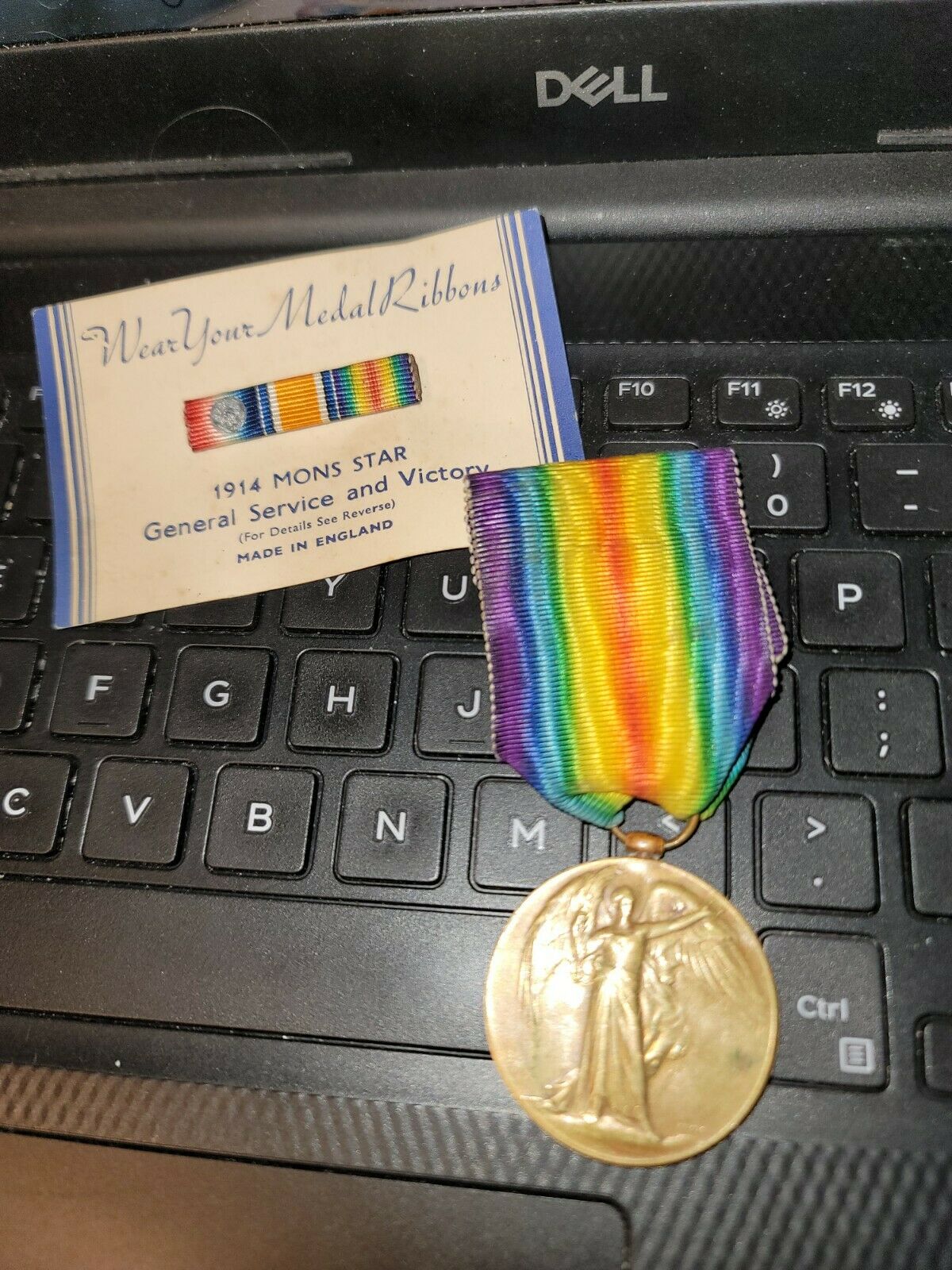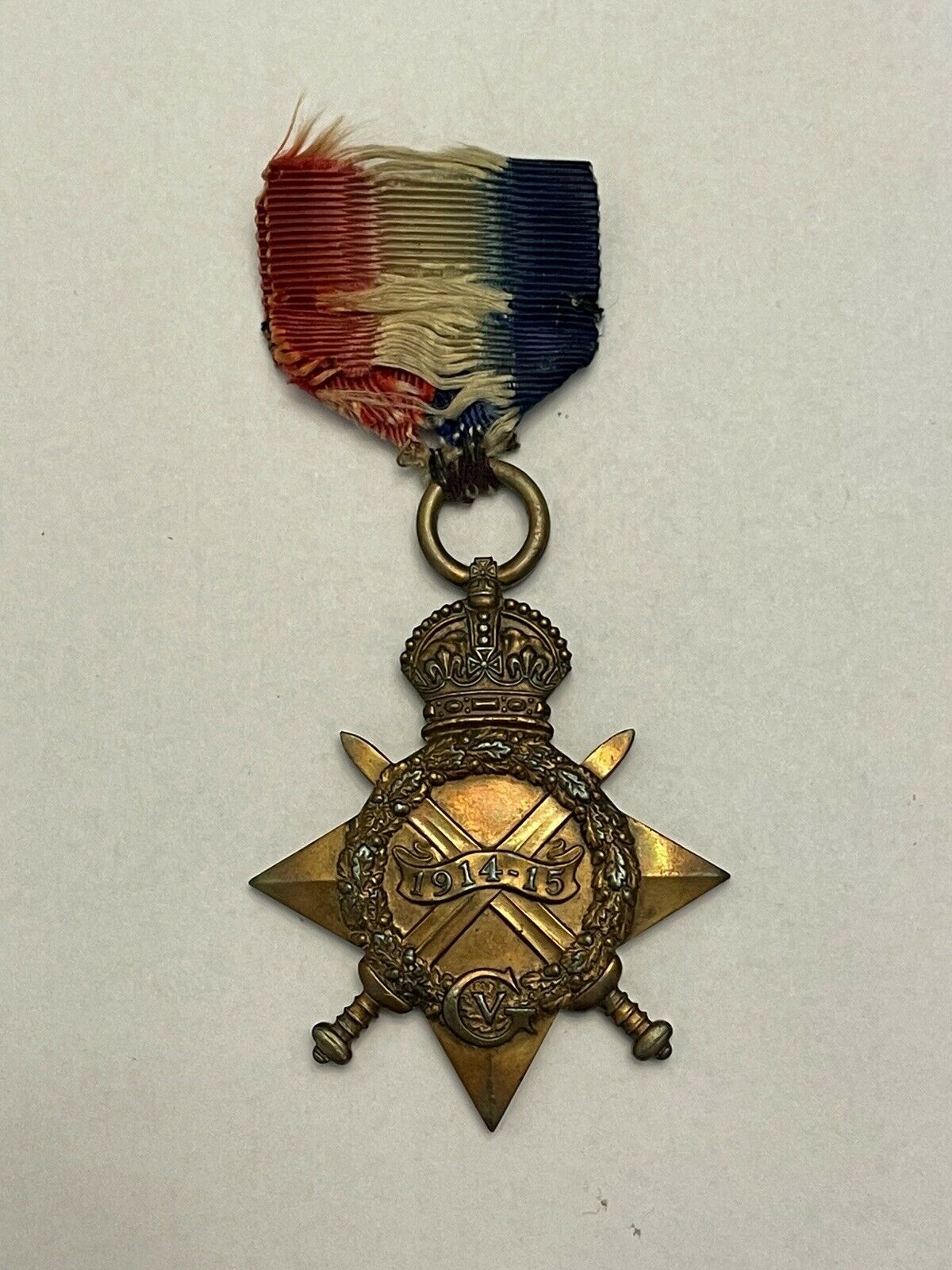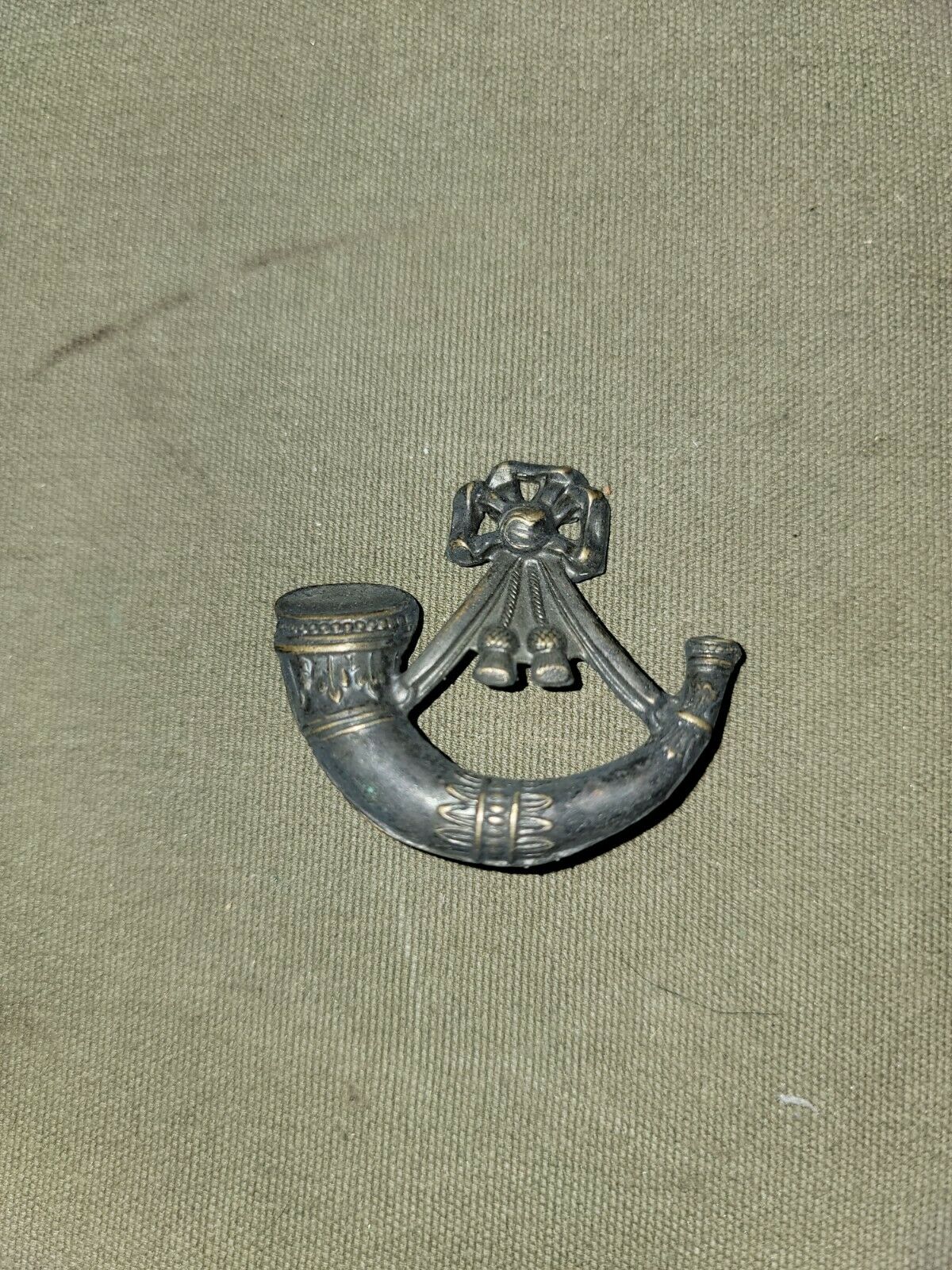-40%
WW1 BRITISH VICTORY MEDAL +RIBBONS NAMED MEDAL SEE STORE WW1 MEDALS
$ 31.67
- Description
- Size Guide
Description
WE SHIP WORLDWIDE 14 EUROPLEASE FOLLOW OUR E BAY STORE
SEE ALL PICS
WE COMBINE SHIPPING ( no shipping fee for the second item when you buy two or more like items )
SALE
SEE OUR STORE
PLEASE READ WHOLE ADD
NOTE: FULL SIZE MEDAL
RIBBONS ARE FULL MINI MEDAL
QIESTION TO BUYERS , YOU DO UNDERSTAND THE MEDAL IS FULL SIZE MEDAL , AND THE RIBBON ARE FOR MINI MEDALS ?
DM2-112670 PTE. T. HEALY A.S.C
Victory Medal (United Kingdom)
From Wikipedia, the free encyclopedia
Jump to navigation
Jump to search
Victory Medal 1914-19
Obverse and reverse of the medal
Type
Campaign medal
Awarded for
Campaign service.
Description
Bronze disk, 36mm diameter.
Presented by
United Kingdom
/
British Empire
Eligibility
British and Imperial forces.
Campaign(s)
First World War 1914-20.
Clasps
None
Established
1 September 1919
Total
Circa 5,725,000
[1]
Ribbon bar
Ribbon bar with
mention in despatches
emblem
Precedence
Equivalent
Victory Medal (South Africa)
Related
1914 Star
1914-15 Star
British War Medal
Territorial Force War Medal
The
Victory Medal
(also called the
Inter-Allied Victory Medal
) is a
United Kingdom
and
British Empire
First World War
campaign medal.
The award of a common allied campaign medal was recommended by an inter-allied committee in March 1919.
[2]
Each allied nation would design a 'Victory Medal' for award to their own nationals, all issues having certain common features, including a winged figure of
victory
on the obverse and the same ribbon.
[1]
Fourteen countries finally awarded the medal.
Eligibility
[
edit
]
The Victory Medal (United Kingdom) was issued to all those who received the
1914 Star
or the
1914–15 Star
, and to most of those who were awarded the
British War Medal
. It was not awarded singly.
[3]
To qualify, recipients need to have served in the armed forces of the United Kingdom or the British Empire, or with certain recognised voluntary organisations, and have entered any theatre of war between 5 August 1914 and 11 November 1918. While home service did not count, United Kingdom based members of the
RAF
who were actively engaged in the air against the enemy did qualify, as did those who flew new planes to France.
[1]
Women qualified for this and other First World War campaign medals while serving in nursing and auxiliary forces in a theatre of war.
[4]
It was also awarded for mine clearance in the North Sea between 11 November 1918 and 30 November 1919 and for participation in the
Allied intervention in the Russian Civil War
up to 1 July 1920.
[5]
Description
[
edit
]
The medal is bronze, circular and 36 millimetres (1.4 in) in diameter. While originally to be of dull bronze, the final award had a clear lacquer coating, giving it a bright finish.
[6]
It was designed by
William McMillan
.
[1]
The obverse shows the winged, full-length, full-front, figure of 'Victory' (or '
Victoria
') with her left arm extended and holding a palm branch in her right hand,
[7]
similar to the statue surmounting the
Queen Victoria Memorial
, in front of
Buckingham Palace
in London.
[8]
The reverse has the words ‘THE GREAT / WAR FOR / CIVILISATION / 1914-1919' in four lines, all surrounded by a
laurel wreath
.
[7]
The 39 millimetres (1.5 in) wide
watered
ribbon has an
iridescent
colour scheme, with the violet moving through to a central red stripe where both schemes meet. It attaches to the medal through a ring suspender.
[1]
The recipient's name, rank, service number and unit were impressed on the edge of the medal. The name of the regiment or corps was omitted on medals awarded to Army officers.
[9]
Those
mentioned in despatches
between 4 August 1914 and 10 August 1920 wear a bronze oak leaf spray on the medal's ribbon, with a smaller version on the ribbon bar when medals were not worn.
[10]
Nicknames
[
edit
]
The three First World War medals, either one of the
1914 Star
or the
1914-15 Star
, the
British War Medal
and the Victory Medal, were collectively irreverently referred to as
Pip, Squeak and Wilfred
, after three comic strip characters, a dog, a penguin and a rabbit, which were popular in the immediate post-war era.
Pip
represented either of the two Stars,
Squeak
represented the British War Medal and
Wilfred
represented the Victory Medal.
[11]
When only the British War Medal and Victory Medal were worn together, they were referred to as
Mutt and Jeff
, after contemporary newspaper comic strip characters.
[12]
Order of wear
[
edit
]
The order of wear of medals awarded for service during the First World War is as follows:
[13]
1914 Star
1914–15 Star
British War Medal
Mercantile Marine War Medal
Victory Medal
Territorial Force War Medal
International award
[
edit
]
In March 1919 a committee in Paris comprising representatives from the various allied powers recommended the award of an inter-allied campaign medal of common design,
[2]
thereby avoiding the need for allied nations to exchange campaign medals.
[4]
Each allied country designed their own version, following certain common criteria. The medal was to be in bronze with a 36 mm diameter, having a winged figure of victory on the obverse, a common inscription on the reverse and suspension by a double rainbow design ribbon.
[2]
Japan and Siam replaced the figure of victory, since a winged victory symbol was not culturally relevant.
[14]
The following versions were finally awarded:
[15]
Country
Designer
Manufacturer
Number issued
Belgium
Paul Du Bois
(1859-1938)
-----
300,000 - 350,000
Brazil
Jorge Soubre (1890-1934)
Casa da Moeda
-
Rio de Janeiro
approximately 2,500
Cuba
Charles Charles
Etablissements Chobillon
6,000 - 7,000
Czechoslovakia
Otakar Španiel (1881-1955)
Kremnice Mint
approximately 89,500
France
Pierre-Alexandre Morlon (1878 - 1951)
Monnaie de Paris
approximately 2,000,000
France
[16]
Charles Charles
Etablissements Chobillon
-----
France
[16]
M. Pautot
Louis Octave Mattei
-----
-----
Greece
Henry-Eugène Nocq (1868-1944)
V. Canale
approximately 200,000
Italy
Gaetano Orsolini (1884-1954)
Sacchini-Milano
S.Johnson-Milano
F.M.Lorioli & Castelli-Milano
approximately 2,000,000
Japan
[17]
Shoukichi Hata
Osaka Mint
approximately 700,000
Poland
[18]
No medal established
Modern 'fantasy' pieces only
-----
Portugal
João Da Silva (1880-1960)
Da Costa
approximately 100,000
Romania
.... Kristesko
-----
approximately 300,000
Siam (
Thailand
)
[19]
Itthithepsan Kritakara
(1890-1935)
-----
approximately 1,500
South Africa
[20]
William McMillan (1887–1977)
Woolwich Arsenal
approximately 75,000
United Kingdom
[21]
William McMillan (1887–1977)
Woolwich Arsenal
Wright & Son
Circa 5,725,000
[1]
United States
James Earle Fraser (1876-1953)
Arts Metal Works Inc.
S.G.Adams Stamp & Stationary Co.
Jos. Mayer Inc.
approximately 2,500,000
Royal Army Service Corps
From Wikipedia, the free encyclopedia
Jump to navigation
Jump to search
"Military Train" redirects here. For military trains in general, see
Train (military)
.
Royal Army Service Corps
George VI Royal Army Service Corps badge. Motto:
Honi soit qui mal y pense
Active
1888-1965
Allegiance
United Kingdom
Branch
British Army
Role
Military administration
Garrison/HQ
Buller Barracks, Aldershot
Nickname(s)
The Moke Train
or
the Commos
Motto(s)
In Arduis Fidelis
(
Faithful in Adversity
)
March
Wait for the Wagon
The
Royal Army Service Corps
(
RASC
) was a
corps
of the
British Army
responsible for land, coastal and lake transport, air despatch,
barracks
administration, the
Army Fire Service
,
staffing
headquarters' units, supply of food, water, fuel and domestic materials such as clothing, furniture and stationery and the supply of technical and military equipment. In 1965 its functions were divided between other Corps (
RCT
and
RAOC
) and the RASC ceased to exist; subsequently, in 1993, they in their turn (with some functions of the
Royal Engineers
) became the "Forming Corps" of the
Royal Logistic Corps
.
History
[
edit
]
For centuries, army transport was operated by contracted civilians. The first uniformed transport corps in the British Army was the
Royal Waggoners
formed in 1794. It was not a success and was disbanded the following year. In 1799, the
Royal Waggon Corps
was formed; by August 1802, it had been renamed
the Royal Waggon Train
. This was reduced to only two troops in 1818 and finally disbanded in 1833.
Direct predecessors
[
edit
]
The Commissariat and the Military Train
[
edit
]
A transport corps was not formed again until the
Crimean War
. In 1855, the
Land Transport Corps
was formed. This was renamed the
Military Train
the following year. The corps was initially based at
Horfield Barracks
in Bristol, but in 1859 the 'Brigade Office' and
Depot
moved to
Woolwich
.
[1]
At this time, supply duties were the responsibility of the
Commissariat
(a uniformed civilian body, principally responsible for food,
forage
and fuel); while provision of arms, ammunition and other critical stores was the responsibility of the
Military Store Department
(formed following the abolition of the
Board of Ordnance
in 1855).
The Control Department
[
edit
]
In 1869, there was a major reorganisation of army supply and transport capabilities: the commissaries of the
Commissariat
and the officers of the Military Train were amalgamated together with the officers of the Military Store Department to form what was called the Control Department under a Controller-in-Chief. The following year,
other ranks
of the Military Train were combined with those of the Commissariat Staff Corps and the Military Store Staff Corps to form a body of soldiers, officered by the Control Department, which was named the
Army Service Corps
(
ASC
). By 1871 new Corps numbered twelve Transport
Companies
, seven Supply Companies and three Ordnance Store Companies, each of around 105
non-commissioned officers
and men.
[2]
From 1870 the Control Department was placed within the new Department of the
Surveyor-General of the Ordnance
, who took over as Controller-in-Chief.
[3]
The Department of the Surveyor General of the Ordnance retained the Control Department and further restructured it into four new divisions superintended by a director: the first was the Supply and Transport Division (formed from the merging of the former commissariat,
purveyors
and barrack departments), the second was an Artillery and Stores Division (that absorbed the former contracts, clothing, ordnance and stores departments) and the third was a Contracts Division. The fourth division created was called the Control Establishments Subdivision that became responsible for the administration of the control departments staff.
[4]
The Commissariat and Transport Department
[
edit
]
In November 1875, the Control Department was abolished and its work in regard to field service was allocated to two new departments: the
Commissariat and Transport Department
and the
Ordnance Store Department
. Following failures in the
Anglo-Zulu War
, the Commissariat and Transport Department was disbanded in January 1880, and replaced with the
Commissariat and Transport Staff
. Although the officers of the former Control Department had been split between the two new departments in 1875, no parallel action was taken with regard to other ranks at that time; the Army Service Corps continued to serve both departments until 1881, whereupon it too was split along similar lines to form two distinct units: and the
Ordnance Store Corps
(which, together with the Ordnance Store Department, would go on to form the
Royal Army Ordnance Corps
) and the
Commissariat and Transport Corps
. The latter retained the Supply Companies (which had their
depot
at
Aldershot
) and the Transport Companies (whose depot was at Woolwich).
[2]
Initially, the Commissariat and Transport Department remained part of the Department of Surveyor General of the Ordnance (in 1878 the Control Establishments Subdivision’s name was altered to the Commissariat and Transport Establishments Division under the supervision of a Commissary General).
[5]
In 1887, however, the Department of the Surveyor General of the Ordnance and its head was abolished; its former functions were then distributed among the several divisions of the Military and Civil Departments: the work of the Supply and Transport Division was allocated to the
Quartermaster General
’s Division.
[6]
Formation of a unified Corps
[
edit
]
1915 recruiting poster
In December 1888, the
Commissariat and Transport Staff
and the
Commissariat and Transport Corps
amalgamated to form a new Army Service Corps, and for the first time officers and other ranks served in a single unified organisation. The
War Department
Fleet was transferred to the Corps in 1891, and the ASC also absorbed some transport elements of the
Royal Engineers
. Furthermore, the Corps of Military
Staff Clerks
was amalgamated into the Supply branch of the ASC in 1893. After it was opened in 1895,
Buller Barracks
in Aldershot came to be regarded as the corps headquarters.
[2]
In 1918, the corps received the "Royal" prefix for its service in the
First World War
and became the Royal Army Service Corps. It was divided into Transport and Supply Branches.
Before the
Second World War
, RASC recruits were required to be at least 5 feet 2 inches tall and could enlist up to 30 years of age (or 35 for tradesmen in the Transport Branch). They initially enlisted for six years with the colours and a further six years with the reserve (seven years and five years for tradesmen and clerks, three years and nine years for butchers, bakers and supply issuers). They trained at
Aldershot
.
[7]
Alone among the "Services" (i.e. rear echelon support corps), RASC personnel were considered to be combatant personnel.
[8]
In 1965, the RASC was merged with the Transportation and Movement Control Service of the
Royal Engineers
(which was responsible for railway transport, inland water transport, port operations, and movements) to form the
Royal Corps of Transport
. All its supply functions,(including the supply of vehicles, their care and preservation in storage and delivery), along with the staff clerks, were transferred to the Royal Army Ordnance Corps, leaving the new RCT solely responsible for transport and movements. In 1993, the RCT and RAOC were merged to form the
Royal Logistic Corps
, the modern descendant of the ASC.
Ranks
[
edit
]
Officers of the Control Department, Commissariat and Transport Department, and Commissariat and Transport Staff held different ranks from the rest of the Army.
[9]
[10]
From February 1885 they were given honorary military ranks, which they held in conjunction with their commissary ranks.
[11]
Officers of the ASC and RASC held full military rank.
Army rank
Control Department rank
Commissariat & Transport Department rank
Commissariat & Transport Staff rank
Second Lieutenant
Sub-Assistant Commissary
Sub-Assistant Commissary
Quartermaster
Lieutenant
Assistant Commissary
Assistant Commissary
Deputy Assistant Commissary-General
Captain
Deputy Commissary
Deputy Commissary
Deputy Assistant Commissary-General
Major
Commissary
Commissary
Assistant Commissary-General
Lieutenant-Colonel
Assistant Controller
Assistant Commissary-General
Assistant Commissary-General
Colonel
Deputy Controller
Deputy Commissary-General
Deputy Commissary-General
Controller
Commissary-General
Commissary-General














